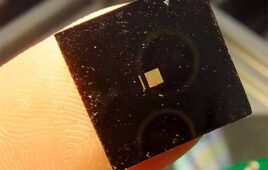
The silicone-textile hybrid sensors are highly flexible and resilient, making them excellent candidates for sensing body movement. [Image from Wyss Institute at Harvard University]
Typical sensors that are used on wearables like heart rate sensors are made of hard, inflexible materials that are restrictive. Because it restricts a user’s natural movements, the data that it is transmitting could be inaccurate.
“We’re really excited about this sensor because by leveraging textiles in its construction, it is inherently suitable for integration with fabric to make ‘smart’ robotic apparel,” said corresponding author Conor Walsh, who is a faculty member at the Wyss Institute, in a press release.
The technology includes a thin sheet of silicone that is poorly conductive between two layers of silver-plated, conductive fabric that are highly conductive to create a capacitive sensor. The sensor registers movement by measuring capacitance change.
“When we apply strain by pulling on the sensor from the ends, the silicone layer gets thinner and the conductive fabric layers get closer together, which changes the capacitance of the sensor in a way that’s proportional to the amount of strain applied, so we can measure how much the sensor is changing shape,” said co-author Daniel Vogt, who is a research engineer at the Wyss Institute.
Fabric is attached to each side of the silicone core with a layer of liquid silicone that is cured. This allows for the silicone to fill all air gaps in the fabric by locking the fabric to the silicone and increasing the surface area for strain distribution and electrical charge storage.
The silicone and fabric combination improves its sensitivity because both materials offer unique properties. The silicone helps the fabric bounce back to its original shape after stretching, and the fabric limits how much the silicone deforms when it is stretched.
Thin, flexible wires are permanently attached to the fabric using a thermal seam so that electrical information from the sensor can be sent to a circuit.
The researchers tested the sensor design using a variety of strain performance tests. The sensor was stretched by an electromechanical tester. They found that the conductive area of the sensor increased as it was stretched which gave it greater-than-expected capacitance.
“Silicone-based capacitive sensors have limited sensitivity based on the nature of material. Embedding the silicone in conductive fabric, however, created a matrix that prevented the silicone from shrinking as much width-wise, which improved sensitivity above that of the bare silicone we tested,” said lead author on the paper Asli Atalay.
The sensor detected capacitance increases within 30 milliseconds of the material being strained and it detected physical change of less than half a millimeter.
Real-world scenarios were also tested. The researchers applied the sensors to a glove in order to measure hand and finger movements in real time. The sensors detected capacitance changes on individual fingers when moved.
“Our sensor’s greater sensitivity means it has the ability to distinguish smaller movements, like slightly moving one finger side-to-side rather than simply whether the whole hand is open or clenched in a fist,” said co-author Vanessa Sanchez.
The research team hopes to further develop this technology to apply it to athletic clothing that tracks physical performance or soft clinical devices that can monitor patients from home.
“This technology opens up entirely new approaches to wearable diagnostics and coupled therapeutics that undoubtedly will play a central role in the future of home healthcare. It also reflects the power inherent in our focus on collaboration here at the Wyss Institute, as it draws insight and inspiration from both Conor Walsh’s Biodesign Lab and Rob Wood’s Microrobotics Lab, which are central to our Bioinspired Robotics platform,” said Donald Ingber, the Wyss Institute’s founding director.
The research was supported by the National Science Foundation, the Scientific and Technological Research Council of Turkey, DARPA and the Warrior Web Program. It was published online in the journal Advanced Materials Technologies.
[Want to stay more on top of MDO content? Subscribe to our weekly e-newsletter.]







